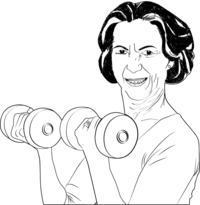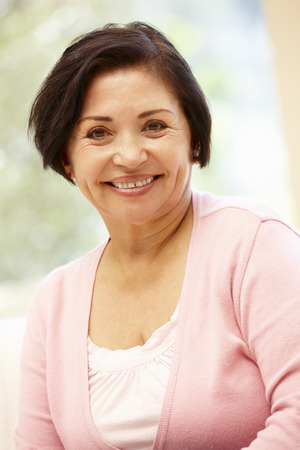Osteoporosis is a musculoskeletal disease. Prevention measures should look to protecting against decline of both bone density and muscle strength. Osteoporosis is chronic and degenerative and asymptomatic. Good nutrition (adequate calcium and Vitamin D) and exercise can increase peak bone mass in healthy people, and can delay the onset of bone problems later in life. (Epidemiology of this disease.) Vitamin D and calcium are more important to the body than many people think, and it's important to have enough in your diet. Some experts believe that phytoestrogens, which naturally occur in plants and are structurally similar to estradiol, contribute to good health, but recent research reveals that they do not deliver the effects that boosters hoped for.
There is also a theory - getting serious credence recently - that an low-acid diet can help maintain bone health. Zinc in the diet may also help. Research has not shown any significant effect on the consumption of soy products or caffeinated beverages on the development of osteoporosis. Research has been unable to find a connection with dietary boron and magnesium either.
Making a concerted effort to incorporate more calcium and vitamin D into the diet as one ages is an easy preventative. The current recommended daily level for vitamin D is 400 IU (International Units), but some experts suggest that increasing it to between 800 and 1000 IU per day will help maintain bone health. Supplements can help maintain optimum calcium and vitamin D levels if the patient doesn’t get enough in the diet. A blood level of 30 nm/ml is considered to be best - this keeps parathormone hormone levels down and bone mineral loss under control. Lower Vitamin D levels may be cause for supplementation.
Calcium supplements are the subject of some controversey. Americans spend an estimated $1 billion per year on calcium supplements.
How would your prevent the drop of bone density to below a certain level? You could try to make bone density higher during the growth phase. Or you could try to slow the loss of mineralization. The peak bone density, usually achieved in the person’s late 20s, is genetic. Exercise, especially weight lifting, can induce bone strength. But people in their teens and 20s usually don’t exercise with the express intent of making their bones stronger or denser. When people start worrying about osteoporosis, they are usually in the phase of their life when the body is in decline. So prevention is focused at slowing the loss of density.
Some health experts advocate prophylactic bisphosphonate treatment to those at high risk. Others feel those drugs are overprescribed and have since they have not been shown to significantly reduce risk for people with osteopenia, should not be given.
Mineralization, microarchitecture, and rate of turnover or remodeling are important processes in bone sturcture and metabolism. The most accurate bone density test is DEXA (dual-energy x-ray absortiometry), which uses minimal amounts of radiation and is general done on the spine and hip in about 10 to 15 minutes. Ultrasound bone density of the heel is a quicker and less expensive test, but not widely available or accepted as an accurate screening test.
A U.S. Surgeon General's Report on osteoporosis suggested at least 30 minutes of weight-bearing exercise per day to significantly reduce one's likelihood of developing osteoporosis.
Although popular magazines focus on calcium and vitamin D, healthy bones require a number of nutrients. Milk is a great food because it contains small amounts of many nutrients. People who suffer from lactose intolerance can attempt to find dairy products with reduced lactose. A serving of milk or yogurt contains about 350 mg of calcium, and fortified products contain even more. Other sources of calcium include dark-green leafy vegetables like kale and turnip greens. A prevention diet can incorporate tofu, canned fish and fortified cereals. It has been suggested that a high protein diet is bad for bone mineralization, but a report in the American Journal of Clinical Nutrition found that was not the case.
Bone density tests are painless, take hardly any time.
Exercise is important throughout the life cycle to ensure healthy, strong bones, increased muscle strength, coordination, and balance. Because bone is living tissue just as muscle is, exercise helps strengthen bones, purge the body of toxins, and maximize physical capabilities.
The best exercise for prevention of osteoporosis is the weight-bearing
kind. Resistance from weight training, dancing, climbing stairs,  and any
cardiovascular activity helps build and maintain strong muscles and a strong,
hearty foundation for our bones. According
to the Surgeon General, at least 30 minutes of physical activity a day
will help us be on our way to having healthy, strong bones.
and any
cardiovascular activity helps build and maintain strong muscles and a strong,
hearty foundation for our bones. According
to the Surgeon General, at least 30 minutes of physical activity a day
will help us be on our way to having healthy, strong bones.
There is also some evidence that beta-blockers, commonly used for hypertension, help prevent the decline in bone density. However, no one suggests these drugs be administered solely for this use. The bone effects are pleitropic.
Doctors have developed the Osteoporosis Risk Assessment Instrument(ORAI) for estimating risk of osteoporosis.
A Canadian study found the ORAI was very effective. It correctly identified the women at risk for low bone density and therefore eliminated the need for many needless DEXA scans.
The International Osteoporosis Foundation has an on-line risk assessment tool at https://www.iofbonehealth.org/iof-one-minute-osteoporosis-risk-test
The World Health Organization developed the FRAX tool to evaluate risk of fracture. More is at http://www.shef.ac.uk/FRAX/. FRAX is an algorithm that was developed from longitudinal studies of people who got osteoporosis. It takes as inputs a person’s age, sex, body mass index, smoking and alcohol use as well as BMD (if available), the patient’s history of bone fracture and arthritis and use of glucocorticoids. The output is a 10-year probability of osteoporotic fracture.
Similar is the QFracture project.
The QFracture Score is a recently developed system for estimating risk
of fracture due to low bone density over the next 10 years. It was
developed in the UK and its supporters are trying to get it used
everywhere. The score takes into account the subject’s age, BMI,
tobacco and alcohol use, and other medical conditions.
Some professionals expressed the concern that the system should
include other conditions COPD and vitamin D deficiency) and medicine
used (e.g. SSRI antidepressants). It is also true that the QFracture system has not been
proven to reduce the number of fractures in large populations, but
that is largely because it is relatively new on the diagnosis scene.
There is a website for finding your QFracture score at http://www.qfracture.org/
Another system is the Simple Calculated Osteoporosis Risk Estimation (SCORE). An on-line version is here: http://depts.washington.edu/osteoed/tools.php?type=score
Public health officials worry about the nutrition and exercise habits of children, because they can have an impact on the physical condition in the long run. It might be possible to lower the incidence of bone disease 60 years from now if kids live healthier today. The federal government even has a program called Better Bones Forever aimed at girls to raise awareness of bone issues and to encourage good eating and physical habits. Click here for what you can do in your 20s to reduce risk. Advice for the middle years.
Caregiving for a person with osteoporosis includes adjusting the living environment to reduce risk of falls and stress. The caregiver also should remain vigilant in ensuring medication is taken on schedule. This can be challenging for once-a-week pills. Reminding the patient to exercise (within reason) and eat well also falls to the caregiver. Keeping doctor's appointments and screenings is also important.
The AAOS has a page on What Is Your Risk for Osteoporosis?
BTM and Osteoporosis Risk Assessment
An exercise plan for people with osteoporosis.

